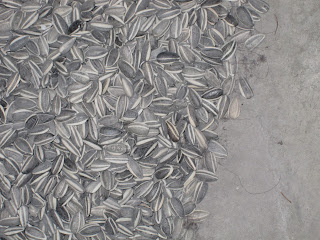On the approach to the Tate’s Turbine Hall there is hardly any suggestion to the sea of sunflowers in the distance. They blend so perfectly into the greyness of there surroundings that it’s only until you look closer you can see them for what they are. All hundred million of them. Each individual painted, each individually made, it’s so breathtakingly unbelievable that it seems almost unreal.
 The Turbine hall is an impressive space to fill, five floors tall with 3,400 square meters of floor space. Between October and March of each year it becomes the home too large specially-commissioned works by contemporary artists, in a series sponsored by Unilever. The series was planned to last 5 years but due to its popularity has been extended until at least 2012. I have visited other works in the collection, such as Doris Salcedo’s ‘Shibboleth’ (http://www.tate.org.uk/modern/exhibitions/dorissalcedo/default.shtm) and Miroslaw Balka's 'How It Is’ sculpture (http://www.tate.org.uk/modern/exhibitions/unilevermiroslawbalka/default.shtm). Weiwei’s ‘Sunflower Seeds’ are in keeping with the Tate’s series. Each piece was interactive, allowing the audience to experience art in a very physical and personal way. They provoke thought,
The Turbine hall is an impressive space to fill, five floors tall with 3,400 square meters of floor space. Between October and March of each year it becomes the home too large specially-commissioned works by contemporary artists, in a series sponsored by Unilever. The series was planned to last 5 years but due to its popularity has been extended until at least 2012. I have visited other works in the collection, such as Doris Salcedo’s ‘Shibboleth’ (http://www.tate.org.uk/modern/exhibitions/dorissalcedo/default.shtm) and Miroslaw Balka's 'How It Is’ sculpture (http://www.tate.org.uk/modern/exhibitions/unilevermiroslawbalka/default.shtm). Weiwei’s ‘Sunflower Seeds’ are in keeping with the Tate’s series. Each piece was interactive, allowing the audience to experience art in a very physical and personal way. They provoke thought, The seeds of doubt: Unfortunately the exhibition has become rather less interactive with the decision to corner off the piece. There were fears that the ceramic dust could be a risk to visitors and staffs health, especially over long term exposure. Mark Brown, Guardian stated “It was like looking at an empty beach from a packed promenade” (http://www.guardian.co.uk/artanddesign/2010/oct/15/tate-modern-sunflower-seeds-ban). Looking at the vacant piece, I have to agree, but there was also something mystifying about that. It was so vast that its emptiness made it haunting. Although this is not how Weiwei envisioned it, it has in no way lost any of its beauty.
 The Turbine hall usually draws in a large audience because it is free so accessible to a large number of people. It’s always well publicised and eagerly anticipated. However, I noticed that with this exhibition the audience weighted more towards the under thirties bracket. The pieces at Turbine are normally more interactive, this attracts a larger audience as people visit for different reasons and you often get people visiting for the fun of interaction not just for the aesthetics. The Tate’s decision to barricade the installation may result in a shift in its demographic and an adverse reaction from those who feel the piece has been comprised. Cynics might construe that this decision is a publicity stunt.
The Turbine hall usually draws in a large audience because it is free so accessible to a large number of people. It’s always well publicised and eagerly anticipated. However, I noticed that with this exhibition the audience weighted more towards the under thirties bracket. The pieces at Turbine are normally more interactive, this attracts a larger audience as people visit for different reasons and you often get people visiting for the fun of interaction not just for the aesthetics. The Tate’s decision to barricade the installation may result in a shift in its demographic and an adverse reaction from those who feel the piece has been comprised. Cynics might construe that this decision is a publicity stunt. Apart from restricting the installations potential the Tate did manage to produce this piece, as always to an extremely high standard. Everything was basic, easy to follow and well presented. The installation also included a short film about the making of the seeds and a series of interactive booths where visitors could film there reactions to the piece and post questions to Ai Weiwei.
I thought this piece was almost other worldly in its beauty. I would urge everyone to go and see it, let me know what you think. Has the Tate been too precautious? Has it become too compliant with laws, too timid and keen to please – after all, isn’t art here to break the barriers?

No comments:
Post a Comment